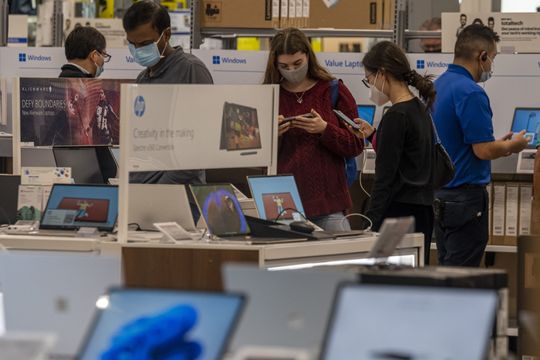Rate of consumer inflation slows to 7.1% from 7.7%
The numbers: The cost of living rose a scant 0.1% in November, the latest in a string of mild readings that suggest the worst U.S. inflation in 40 years is receding.
Economists polled by The Wall Street Journal had forecast a 0.3% increase in the consumer price index. Falling gas prices have helped tug inflation lower since last summer.
The annual rate of inflation, meanwhile, fell to 7.1 % from 7.7% in the prior month, marking the lowest level since the end of 2021. Inflation peaked at 9.1% in June.
The modest rise in inflation in November gave a big lift to stock prices. Wall Street hopes waning inflation will let the Federal Reserve scale back how much it raises U.S. interest rates.
The Fed on Wednesday is widely expected to raise a key short-term interest rate by 1/2-point, but it would be a step down from the 75-basis-point hikes in the prior four meetings stretching back to June.
The so-called core rate of inflation, which omits food and energy, rose 0.2%. That’s the smallest gain since August 2021. Wall Street had forecast a 0.3% increase.
The advance in the core rate over the past year dropped to 6% from 6.3%. The Fed views the core rate as a more accurate predictor of future inflation trends.
Key details: The cost of gasoline declined again and helped pave the way for the slowdown in U.S. inflation since the summer. A gallon of gas costs about the same now as it did before the Russian invasion of Ukraine.
The cost of food rose 0.5% in November, however, and prices are sharply higher compared to a year ago. Grocery expenses have shot up 12% in the past 12 months, the biggest increase in decades.
Used-vehicle prices fell for the fifth month in a row. Soaring prices of used vehicles played a big role in the spike in inflation early on.
The overall cost of goods — minus food and energy — slowed again. They are up 5.1% in the past year, but that’s down from a peak of 12.3% last February.
Service inflation is the bigger bugaboo for the economy now. Most companies fall into this category, and they employ most of America’s workers.
Service inflation minus energy rose 0.4% in November. In the past year, service inflation has climbed 6.8%, the fastest pace since 1982.
Among services, rents jumped 0.8%. The cost of car insurance, communications and recreation also rose sharply.
Service inflation is harder to root out because labor is the biggest expense for most companies. Hourly wages have risen 5.1% in the past 12 months, one of the fastest rates in decades.
Workers haven’t benefited, however, because inflation has climbed even faster. Wages have actually fallen 1.9% over the past year after adjusting for inflation.
Big picture: Prices aren’t rising as fast now as they were earlier in the year, but economists and Fed officials say inflation probably won’t return to pre-covid levels of 2% until 2024 or even 2025.
The Fed aims to bring down inflation by raising interest rates high enough to reduce the demand for labor, goods and services.
The big question is whether the Fed can do so without triggering a recession. Most economists are skeptical — they predict a downturn is likely in 2023.
Looking ahead: “The Fed will likely need to keep monetary policy on a restrictive footing into the new year and perhaps even through a sizable chunk of 2023 before it can be confident that the inflation scourge is squashed,” said Jason Pride, chief investment officer of private wealth at financial management firm Glenmede.
“In the meantime, the U.S. economy continues to face material risks from tight monetary policy, with the likelihood of recession elevated heading into the new year.”
Market reaction: The Dow Jones Industrial Average DJIA, +0.30% and S&P 500 SPX, +0.73% surged in Tuesday trades. The yield on the 10-year Treasury note TMUBMUSD10Y, 3.497% sank to 3.45%.

